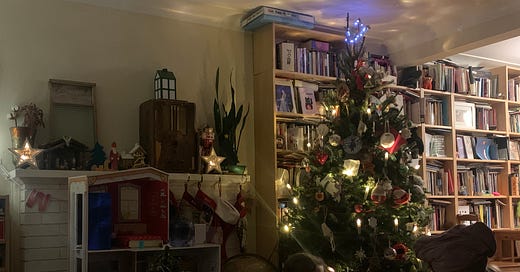the green notebook
, reading Carrie Olivia Adams, Mei-mei Berssenbrugge, Joe Brainard + Daniel Felsenthal on Joe Brainard,
Quiet, as we head towards holidays. Two weeks of our young ladies at home. For Rose, within a different school board, two weeks plus a day.
Chicago poet Carrie Olivia Adams’ monthly substack offers her “Rituals for a Winter of Uncertainty”: “I’m finding myself having a harder time than ever keeping up with the fleeting days of December as the year rushes to a close. And what’s waiting for us on the other side in January but a lot of uncertainty?” Of the dozens of newsletters I seem to follow, hers is one of the few that I read immediately and in full (alongside missives by Douglas Glover, Amanda Earl, Cara Waterfall, etcetera), and appears to be dedicated to taking and catching one’s breath. At times, I’m uncertain if the direction is meant for her readers or herself. Perhaps both.
What separates a ritual from a routine is the breath it allows you to take, to hold yourself still for a moment, inhabiting the action itself rather than its outcome. It’s not about checking off the boxes or going through the motions or whatever your favorite common idiom of routine may be. Instead, ritual requires a consideration of how and why you are doing the thing that you’re doing, and it creates a space for thought, reflection, comfort, and care. For me, ritual and contentment go hand in hand.
The ritual, of her monthly substack. My last few weeks, a December pushing to work out from under the overload of November. One month, and another. Is this all about time.
Further to home office excavation and hollowing-out, Mei-mei Berssenbrugge’s Empathy (1989). “There is a craft at work / to reconcile emotion in a purely speculative ambience, / tracking the last aria,” she writes, to end her poem “Duration of Water,” “like a duration of water / which is a piece of white silk.”
*
I’d pulled it aside a week or three ago for later viewing, finally moving through this article by Daniel Felsenthal online at The Baffler, “No Ordinary Joe,” a piece subtitled “Reading the letters of Joe Brainard.” Edited by Daniel Kane, Love, Joe: The Selected Letters of Joe Brainard (2024) appeared a few weeks back, self-described as “a selection of Brainard’s letters stretching from 1959 to 1993, offering an intimate view of his personal and artistic life. They allow readers to witness an extraordinarily fertile moment in New York’s history, when literary and visual arts intersected with happenings, proto-punk and psychedelic rock concerts, and experimental music and dance performances.” Most of my knowledge of legendary American artist and writer Joe Brainard (1941-1994) originated through the lens of poets surrounding the New York School, including his interactions with Ron Padgett and Ted Berrigan, with subsequent echoes and references rippling across further poets over the years, including by Cobourg poet, writer and editor Stuart Ross. Really, there are elements of my coming to Brainard comparable to how I came to the work of Greg Curnoe, Roy K. Kiyooka, Dennis Tourbin or Diane Woodward: it was the poets that brought me here.
Felsenthal’s review offers Brainard as a beloved figure in the swirl of his art and literary communities, and how his work connected deeply and intimately to whoever might encounter it:
To read Joe Brainard or to see his art is to know him, to talk with him, to fuck him, or at least to try fooling around before you grab a meal together and resolve to be friends. He might be one of the most honest writers of the twentieth century; Brainard certainly did a great job of playing the part. And like anyone who is basically worthwhile, his friends maintained their belief in him by selectively ignoring his more ordinary qualities in favor of his exceptional ones.
Thinking back, my first real awareness of Brainard might have been through Vancouver writer George Bowering, prompted by his memoir on the late London, Ontario artist Greg Curnoe: The Moustache: Memories of Greg Curnoe (1993), composed as daily stand-alone recollections on his late friend until the manuscript accumulated, cohered. Bowering offered at the time that his project was influenced by Je Me Souviens (1978) by French novelist and filmmaker Georges Perec (1936-1982), which was, itself, influenced by Joe Brainard’s I Remember (1975). In Brainard’s original typescript, writing:
I remember a dream of meeting a man made out of a very soft yellow cheese and when I went to shake his hand I just pulled his whole arm off.
Who do I feel Joe Brainard travelled into the future to crib from Vancouver poet Mark Laba? Although: even as I’m writing this, I can hear Brainard’s sentences in Stuart Ross’ voice. Come to think of it, I’ve never seen Ross and Brainard together in the same room, at the same time. Is this coincidence?
I am thinking on letters, and archives. I am thinking upon the mound of Christmas cards that await the end of mail strike. Apparently today Canada Post employees have been ordered back to work, but it will be another two days before they’re accepting new mail. They have to get through the backlog. I will be writing letters.
I briefly entertained the idea of composing an “I Remember” following the death of my friend Clare Latremouille (1964-2022), but found myself pouring everything I had into a two or three page obituary immediately following the announcement of her death. Beyond that, I was too exhausted to write anything further.





I love "how I came to the work of Greg Curnoe, Roy K. Kiyooka, Dennis Tourbin or Diane Woodward: it was the poets that brought me here."